
This lesso material includes the water cycle along with the three main keywords ( evaporation , condensation , and Precipitation) explained.
- Subject:
- Atmospheric Science
- Material Type:
- Lesson
- Author:
- zainab osman
- Date Added:
- 11/24/2022

This lesso material includes the water cycle along with the three main keywords ( evaporation , condensation , and Precipitation) explained.

The water cycle describes how water evaporates from the surface of the earth, rises into the atmosphere, cools and condenses into rain or snow in clouds, and falls again to the surface as precipitation. ... The cycling of water in and out of the atmosphere is a significant aspect of the weather patterns on Earth.

A lesson on The Water Cycle for lower elementary students. Lesson includes colorful pictures, a video, game, and assessement for teachers to use.

The water cycle describes how water evaporates from the surface of the earth, rises into the atmosphere, cools and condenses into rain or snow in clouds, and falls again to the surface as precipitation. ... The cycling of water in and out of the atmosphere is a significant aspect of the weather patterns on Earth.

The water cycle describes how water evaporates from the surface of the earth, rises into the atmosphere, cools and condenses into rain or snow in clouds, and falls again to the surface as precipitation. ... The cycling of water in and out of the atmosphere is a significant aspect of the weather patterns on Earth.

The water cycle game helps you learn how water molecules move through various places including rivers, the ocean, the earth’s surface, the atmosphere and clouds. Actions such as evaporation, runoff, condensation, precipitation, soil absorption and ground water expansion move water from one zone to another.
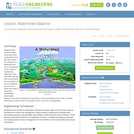
Students learn about the water cycle and its key components. First, they learn about the concept of a watershed and why it is important in the context of engineering hydrology. Then they learn how we can use the theory of conservation of mass to estimate the amount of water that enters a watershed (precipitation, groundwater flowing in) and exits a watershed (evaporation, runoff, groundwater out). Finally, students learn about runoff and how we visualize runoff in the form of hydrographs.

The 11 books selected for inclusion in the issue of Beyond Weather and the Water Cycle devoted to climate studies range from easy readers to biographies. Each book is briefly described; all were reviewed for accuracy and appropriate reading levels for students in grades K-5. Several books deal with careers in meteorology.
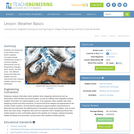
Students are introduced to the basics of the Earth's weather. Concepts include fundamental causes of common weather phenomena such as temperature changes, wind, clouds, rain and snow. The different factors that affect the weather and the instruments that measure weather data are also addressed.
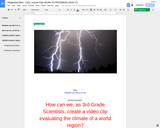
Learning Goals/Outcomes/Objectives:
Observable features of the student performance by the end of the grade: 1). Obtaining information: Students use books and other reliable media to gather information about: i. Climates in different regions of the world (e.g., equatorial, polar, coastal, mid-continental). ii. Variations in climates within different regions of the world (e.g., variations could include an area’s average temperatures and precipitation during various months over several years or an area’s average rainfall and temperatures during the rainy season over several years). 2 Evaluating information a Student's combine obtained information to provide evidence about the climate pattern in a region that can be used to make predictions about typical weather conditions in that region. 3 Communicating information a Students use the information they obtained and combined to describe*: i. Climates in different regions of the world. ii. Examples of how patterns in climate could be used to predict typical weather conditions. iii. That climate can vary over years in different regions of the world.
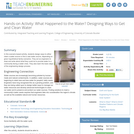
In this scenario-based activity, students design ways to either clean a water source or find a new water source, depending on given hypothetical family scenarios. They act as engineers to draw and write about what they could do to provide water to a community facing a water crisis. They also learn the basic steps of the engineering design process.
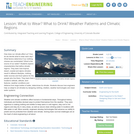
How does our climate affect us? How do we decide what to wear each day? What factors determine if our clothing choices are comfortable? What is the source of our water? Students explore characteristics that define climatic regions. They learn how tropical, desert, coastal and alpine climates result in different lifestyle, clothing, water source and food options for the people who live there. They learn that a location's latitude, altitude, land features, weather conditions, and distance from large bodies of water, determines its climate. Students discuss how engineers help us adapt to all climates by designing clothing, shelters, weather technologies and clean water systems.
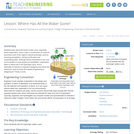
Students learn about the Earth's water cycle, especially about evaporation. Once a dam is constructed, its reservoir becomes a part of the region's natural hydrologic cycle by receiving precipitation, storing runoff water and evaporating water. Although almost impossible to see, and not as familiar to most people as precipitation, evaporation plays a critical role in the hydrologic cycle, and is especially of interest to engineers designing new dams and reservoirs, such as those that Splash Engineering is designing for Thirsty County.

This resource is a video abstract of a research paper created by Research Square on behalf of its authors. It provides a synopsis that's easy to understand, and can be used to introduce the topics it covers to students, researchers, and the general public. The video's transcript is also provided in full, with a portion provided below for preview:
"Most climate models tend to agree on the Earth’s future when it comes to temperature: at our current pace of greenhouse gas emissions, it’s going to get hotter everywhere. That makes intuitive sense. What’s less obvious is what’s going to happen to precipitation. Models are generally in much weaker agreement about precipitation changes, but they seem to converge in predicting that certain areas are definitely going to get wetter and others drier. Among these, the Mediterranean stands out. Locally, the region may lose up to 40% of its winter precipitation. For the millions who depend on these seasonal rains, it’s a serious threat to their way of life. But researchers have yet to explain why numerous climate models settle on the same fate. Now, researchers from MIT have discovered two mechanisms that could converge to create this dire scenario: strengthening winds in the upper troposphere, at an altitude of about 10 km, and a diminishing temperature difference between land and sea..."
The rest of the transcript, along with a link to the research itself, is available on the resource itself.